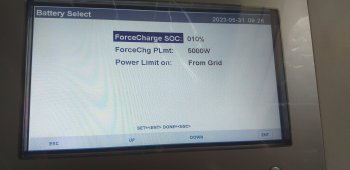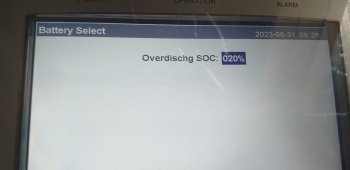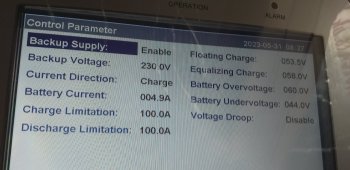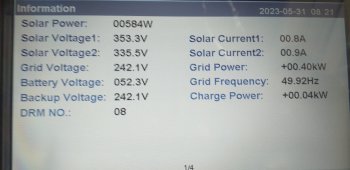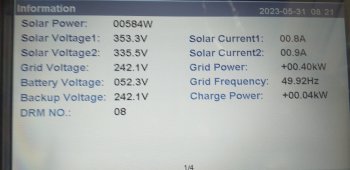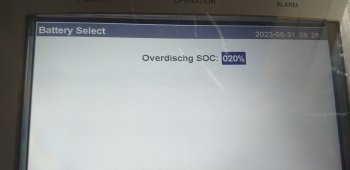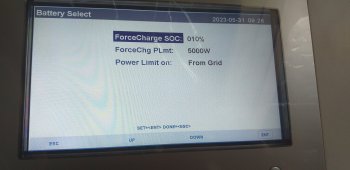In December 2022 a local solar company fitted 23 x Trina Vertex S390W panels in two strings. 10 of the 23 panels have optimisers fitted. They connected these strings to a Solis 6KW (rhi-6k-48es-5g) Hybrid Inverter and two Puredrive 5KW batteries. The system is connected to the grid as a producer and consumer of grid electricity.
On very sunny days, between 1100 and 1200 local time, the inverter will switch off for a few minutes recording a “DC input overcurrent fault”. I can see from the graphs available that this occurs when the batteries move from 99% to 100% charged and the inverter DC voltage, spikes from 2x 330v (=720v) to 2 x 387v (=774v). At other times of the day, when the battery reaches 100%, the DC voltage is not as high and the inverter does not switch off. Amps do not rise above 10.3A on each string, at any time.
The technical info for this inverter is:
Input DC (PV side)
Recommended max PV power 8000w
Max input voltage 600v
Rated voltage 330v
MPPT voltage range 90-520v
Full load MPPT voltage range 280-520v
Max input currant 11A/11A
Max short circuit current 17.2A/17.2A
I sense that there is a safety issue here, which will increase as summer develops. Too many volts suggests to me that some component might overheat and ignite, or its electronics burn out, or that the inverter fails completely, as the inverter would not switch itself off if there were no safety issues. I have not contacted the supplier company as the two technical people they had, have both left after completing my installation, having fallen out with the company’s new sales-driven owner. I wonder if I have been sold too may panels or if there needs to be an extra bit of voltage-limiting kit between the input strings and the inverter?
I would welcome your advice as to what I can do, or get done, to sort this problem out.
On very sunny days, between 1100 and 1200 local time, the inverter will switch off for a few minutes recording a “DC input overcurrent fault”. I can see from the graphs available that this occurs when the batteries move from 99% to 100% charged and the inverter DC voltage, spikes from 2x 330v (=720v) to 2 x 387v (=774v). At other times of the day, when the battery reaches 100%, the DC voltage is not as high and the inverter does not switch off. Amps do not rise above 10.3A on each string, at any time.
The technical info for this inverter is:
Input DC (PV side)
Recommended max PV power 8000w
Max input voltage 600v
Rated voltage 330v
MPPT voltage range 90-520v
Full load MPPT voltage range 280-520v
Max input currant 11A/11A
Max short circuit current 17.2A/17.2A
I sense that there is a safety issue here, which will increase as summer develops. Too many volts suggests to me that some component might overheat and ignite, or its electronics burn out, or that the inverter fails completely, as the inverter would not switch itself off if there were no safety issues. I have not contacted the supplier company as the two technical people they had, have both left after completing my installation, having fallen out with the company’s new sales-driven owner. I wonder if I have been sold too may panels or if there needs to be an extra bit of voltage-limiting kit between the input strings and the inverter?
I would welcome your advice as to what I can do, or get done, to sort this problem out.





